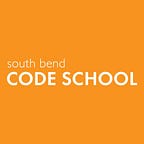Should My Child Learn to Code with Scratch?
The perfect program for our aspiring young coders, Ages 7–12!
Many of our participants’ parents/guardians have varying levels of coding experience themselves but ALL are looking for the best course to enroll their students in. If your child is between the ages of 7–12, we think that Scratch is a great place to get started.
Visual coding is real coding because of the skills that you learn.
Scratch is a block-based coding language. Code is the language that computers use and it allows people to use the language to relay instructions to the computer. There are hundreds of coding languages out there and Scratch is one of them. Through Scratch, our team teaches participants how to use visual elements to learn the fundamentals of many professional programming languages (ex. Python, C++, or JavaScript). For example, through Scratch, participants learn how to snap blocks together in the right sequence to make a character move to the right or program a calculator to add numbers together. With Scratch, students learn key coding concepts that are relevant to many professional programming languages such as loops (repeat blocks)and conditionals (if-then blocks), variables, and functions.
Participants also practice programmer techniques such as writing clean code, debugging, and documentation. Through Scratch, our team helps students to learn these programming skills in a forgiving environment.
Scratch helps a coder grow a programmer’s mindset while having fun.
Scratch’s forgiving environment empowers kids because it helps young minds develop a personal connection with coding. The colorful environment and animated characters create a friendly space for kids to try coding.
Dragging blocks instead of writing code helps kids to not get caught up in syntax errors but to focus on developing the logic skills that programming requires. In other words, Scratch sets students up for success because the program helps students to grow their programmer’s mindset, all while being creative and having fun.
Scratch is a creative outlet.
In Scratch, students have the opportunity to explore a variety of creative paths and develop a lot of different skills! Students can become designers, coders, or animators.
When learning environments encourage creative thinking, kids have the opportunity to feel invested in their projects. We’ve seen students express their creative interests by coding their own fashion shows or creating their own logo designs and using code to really make the logo “come to life”. We’ve seen participants combine their love for sports with their interest in programming by coding a virtual baseball game.
In other words, Scratch encourages creative thinking by offering kids an outlet to learn how to code while building fun, creative projects such as games and animations that they care about.
In our classes, we see kids get so excited about the game that they’re building that they aren’t discouraged when there’s a bug in their code and the game stops working. Instead, they are encouraged to find a solution to their problem, even when the answer is not obvious. They also have guidance from our coding instructors so they get to learn in a supportive environment.
With the answer not always being clear and the students being the creative directors, we see that once a student finishes a project, their confidence only grows.
Scratch boosts students’ self-esteem
Coding can be challenging but when taught correctly, students feel motivated and encouraged when building their coding projects. In our classes, we see an increase in Scratch participants’ self-confidence and openness to increasing their abilities. Once a student completes a difficult coding challenge, we see a noticeable difference in that student’s willingness to try other things (whether that be new coding languages or exploring passions that exist outside of coding). In addition to strengthening a learner’s confidence, as we mentioned, Scratch also strengthens learners’ logic and critical thinking skills, giving them a stronger foundation for exploring new skills or interests.
All in all, Scratch is an excellent option for kids ages 7–12. Whether a student is new to coding or experienced and looking to grow their skills, Scratch provides an outlet for learners to develop real-world coding skills that can benefit them both in and outside of the programming world. Students get so excited about the skills that they’re learning and the projects that they’re building that the icing on top is getting to share their projects with their friends.
Our virtual coding classes are small class sizes, giving kids the opportunity to closely work with an instructor and form a tight nit community with their peers. Students are encouraged to share their projects with one another, work together, and become better programmers together.
If you’d like to learn more about our Fall program, click here.
To learn more about our other coding courses or teen programs for ages 13–18, visit southbendcodeschool.com.
Thanks for reading! If there’s ever anything that we can do to help you along your coding journey, don’t hesitate to drop us a line at info@southbendcodeschool.com.
